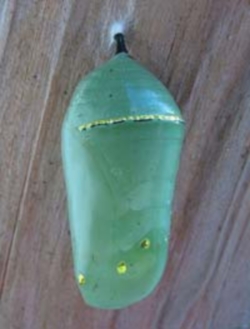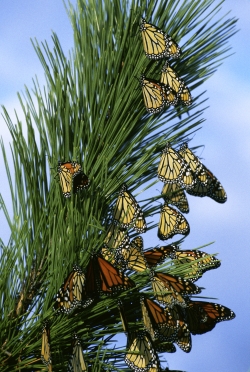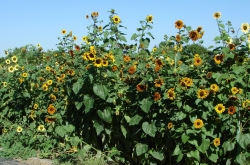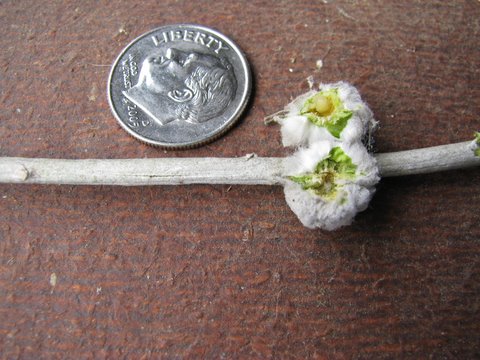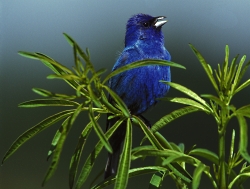 Indigo Bunting
Indigo Bunting
Passerina cyanea
Courtesy US FWS
Steve Maslowski, Photographer
 Spring Azure(Male)
Spring Azure(Male)
Celastrina ladon
Courtesy Wikimedia,
D. Gordon E. Robertson, Photographer
Licensed under Creative Commons
Attribution-Share Alike 3.0 Unported
Holly: Hi, I’m Holly Strand.
If I were to ask you what your favorite color is, odds are your answer would be blue. All around the world most people prefer blue over any other color.
Maybe this is because blue is quite unusual in nature. We rarely see blue in animals or plants. Animals are brown, ruddy or grayish—sometimes white or black makes an appearance. Plants are green, brown, red and yellow. So the blue exceptions really stand out.
There are two main ways to be blue. The first way is thorough pigmentation. Pigments are chemical substances that selectively absorb light. We see color based on the light wavelengths that are not absorbed but reflected. For it is these reflected wavelengths that hit our eyes.
Blue flowers are the result of anthocyanin pigments. These pigments usually reflect red or purple, but in Uinta’s Alpine Forget-me-nots they create a pure sky blue that will stop you in your tracks.
The other way to be blue is through a physical rather than chemical approach. A physical or structural color is produced when incoming light interacts with nanoscale biological structures on an object’s surface. In birds, different shapes and sizes of tiny air pockets and keratin in feathers can cause different shades of blue. The lazuli bunting gets its bright blue head and back via structural color. So do indigo buntings and mountain bluebirds.
Some birds change color depending upon the angle at which you look at them. This shimmering iridescence is caused by a more complex interplay of light and feather structure which sends light bouncing off into different directions. Some of the light waves coincide to intensify color; nd others crash and cancel each other out. In Utah look for iridescent blue on the head and back of the tree swallow and on the black-billed magpie’s wing and tail.
Iridescence is quite common in insects—think of colorful beetle and butterfly wings . The dazzling morpho is the most striking example of an iridescent blue. While we don’t have morphos in Utah, we do have several species of butterfly in a subfamily group of the gossamer winged butterflies. This group is appropriately called “ the blues.”
By now Utah’s blue creatures have mostly expired or flown south. However, you can still get your blue color fix. Just look up! Utah’s sky is a deep and satisfying blue due to our aridity and high elevation.
For Wild About Utah, I’m Holly Strand.
Credits:
Image: Courtesy and Copyright 2003 Michael Kuhns, Extension.usu.edu
Text: Holly Strand
Sources & Additional Reading:
Color
Angier, Natalie. True Blue Stands Out in an Earthy Crowd. NY Times. Oct 22, 2012
https://www.nytimes.com/2012/10/23/science/with-new-findings-scientists-are-captivated-by-the-color-blue.html?emc=eta1
Fields, Helen. Why Are Some Feathers Blue? https://www.smithsonianmag.com/science-nature/Why-Are-Some-Feathers-Blue.html [accessed November 15, 2012]
Murphy, Pat, and Paul Doherty. 1996. The Color of Nature: An Exploratorium Book San Francisco: Chronicle Books
WebExhibits. Causes of Color. https://www.webexhibits.org/causesofcolor/15A.htm l [accessed November 15, 2012]
Color Preference
Grieve, K.W. (1991), “Traditional Beliefs and Colour Perception,” Perceptual and Motor Skills, 72 (4], 1319-23.
Krishna, K.P. (1972), “Colour Preferences as a Function of Age and
Sex,” Journal of the Indian Academy of Applied Psychology, 9 (1), 10-13.
Madden, Thomas, Kelly Hewett, and Martin S. Roth. 2000. Managing Images in Different Cultures:
A Cross-National Study of Color Meanings and Preferences. Journal of International Marketing. Vol. 8. No 4 pp. 90-107



